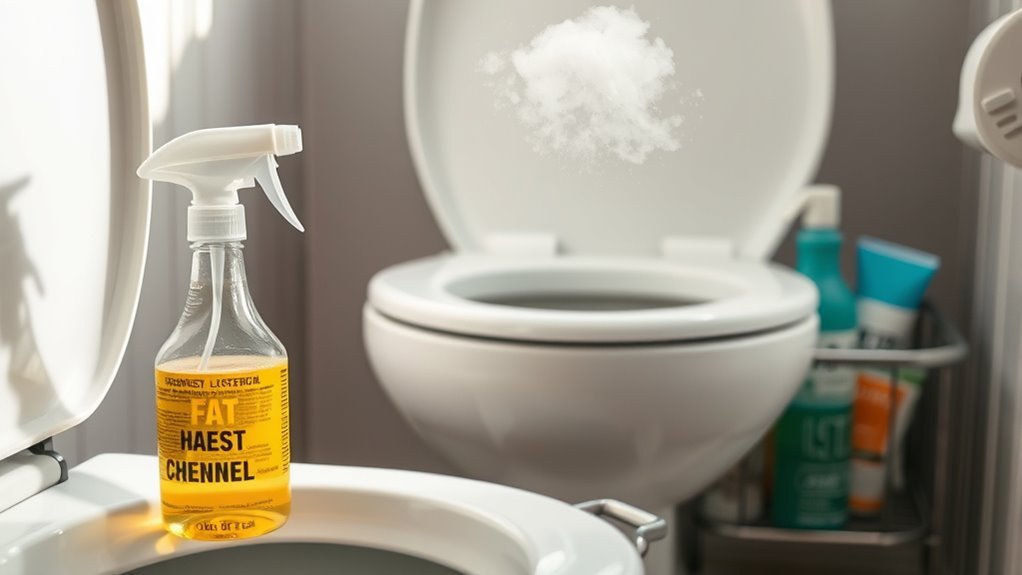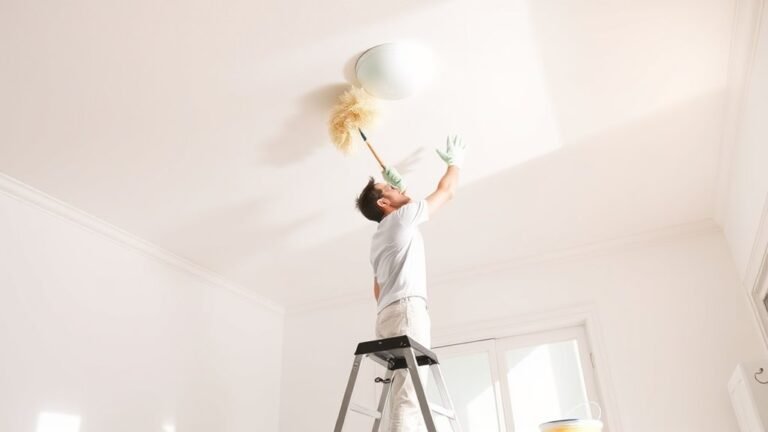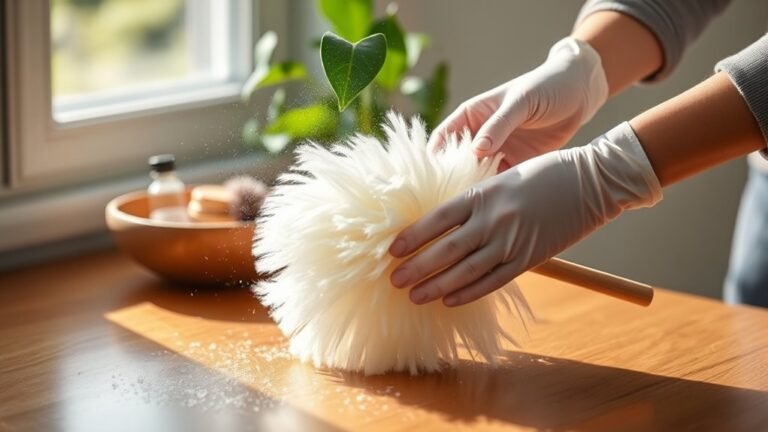Mistakes to Avoid When Cleaning Your Toilet
When cleaning your toilet, don’t use harsh chemicals like bleach that can damage the surface over time. Always wear gloves to protect your skin, and avoid sharing cleaning cloths with other surfaces to prevent cross-contamination. Don’t skip cleaning under the rim or neglect the tank and handle, where germs hide. Also, make sure the area’s ventilated and give cleaners enough dwell time to work. Use soft brushes, not abrasive tools, to avoid scratches. If you want to improve your technique, there’s more to explore.
Using Harsh Chemicals That Damage the Toilet Surface
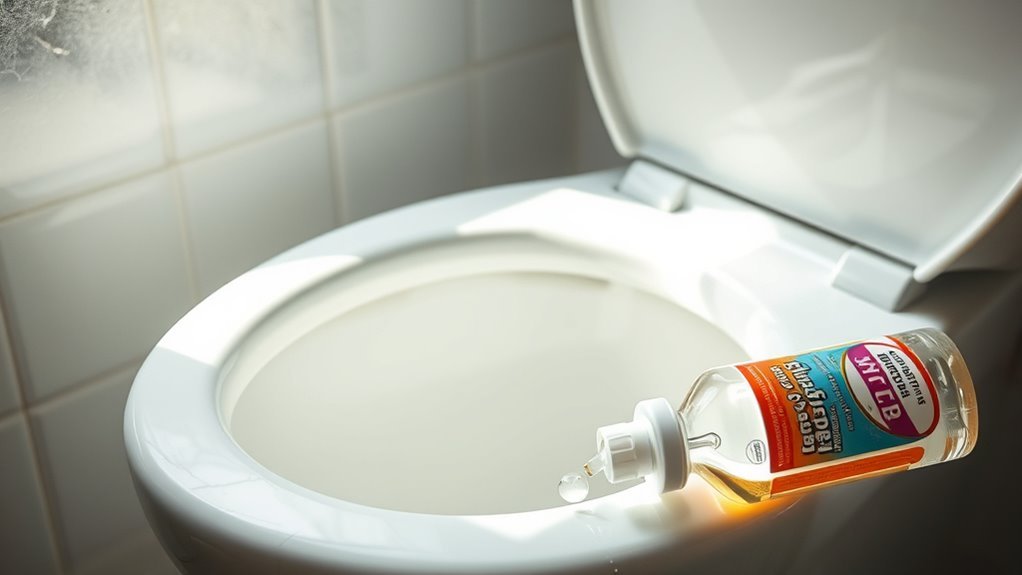
While it might seem effective to use strong cleaners, harsh chemicals can actually damage your toilet’s surface over time. You want to maintain both cleanliness and surface protection, so avoid bleach or abrasive powders that erode the finish. Instead, opt for chemical alternatives like vinegar or baking soda, which clean effectively without compromising the porcelain. These safer options help preserve the integrity of your toilet while reducing exposure to toxic substances. Remember, protecting your toilet’s surface extends its lifespan and keeps it looking fresh. By choosing gentler products, you retain control over your cleaning routine without sacrificing results. Resist the urge to rely on aggressive chemicals; your toilet deserves care that balances power with preservation. This approach supports your freedom to maintain a spotless bathroom safely and sustainably. Using natural cleaning solutions not only avoids harsh chemicals but also promotes health and environmental safety.
Ignoring the Toilet Tank and Handle
You can’t skip cleaning the toilet tank interior since grime and buildup hide there, affecting flush performance. The handle is another hotspot for germs that you must disinfect regularly to prevent spreading bacteria. Make these areas part of your routine to maintain a fully sanitary toilet. Following proper disinfection techniques ensures effective sanitization of these critical components.
Neglecting Tank Interior
Even if the toilet bowl gets all the attention, neglecting the tank interior can lead to serious problems like mineral buildup and malfunctioning parts. You need to prioritize tank maintenance as part of your regular cleaning schedule. Mineral deposits and sediment accumulate inside the tank, impairing the flushing mechanism and causing leaks. To prevent this, inspect the tank every few months, scrubbing away buildup with a non-abrasive brush and using a vinegar solution for mineral deposits. Avoid harsh chemicals that can damage components. Maintaining the tank guarantees smooth operation and extends your toilet’s lifespan. Don’t let this hidden area become a source of costly repairs. By integrating tank cleaning into your routine, you maintain both functionality and freedom from unexpected plumbing issues.
Overlooking Handle Germs
Anyone touching the toilet handle is exposed to germs that often go unnoticed during cleaning. You need to prioritize handle hygiene because the toilet handle is a primary germ hotspot. While scrubbing the bowl, many overlook the tank and handle, leaving harmful bacteria intact. To maintain true cleanliness and freedom from illness, disinfect these areas regularly with an antibacterial cleaner or wipes. Don’t forget to clean underneath and around the handle, where germs can accumulate unnoticed. Ignoring these spots compromises your entire cleaning effort and exposes you to avoidable risks. Make handling germ hotspots a non-negotiable part of your routine to guarantee thorough toilet hygiene and protect your health effectively.
Skipping Gloves and Protective Gear
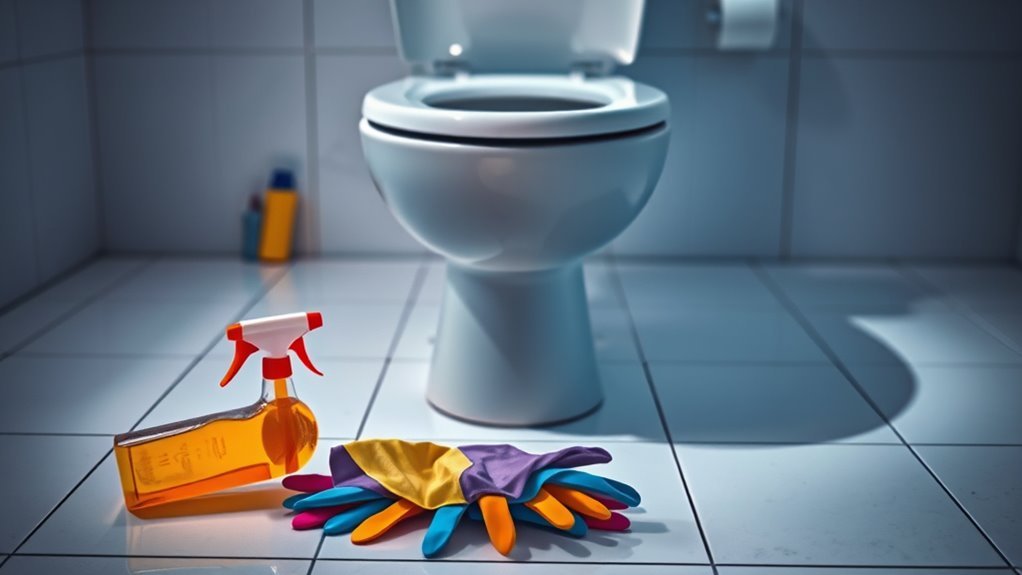
You shouldn’t skip gloves and protective gear when cleaning your toilet because your hands are exposed to harmful bacteria and harsh chemicals. Wearing proper protection prevents skin irritation and reduces the risk of chemical burns. Always equip yourself to maintain safety and hygiene throughout the cleaning process.
Importance of Hand Protection
Although it might seem like a minor step, skipping gloves and protective gear when cleaning your toilet exposes your skin to harsh chemicals and harmful bacteria that can cause irritation or infections. Prioritizing hand hygiene with proper protective equipment shields you from these risks and guarantees safe cleaning.
| Risk | Protective Measure |
|---|---|
| Chemical irritation | Use rubber gloves |
| Bacterial infections | Wear disposable gloves |
| Skin dryness/cracking | Apply barrier cream |
| Cross-contamination | Change gloves frequently |
| Allergic reactions | Choose hypoallergenic gear |
Preventing Chemical Exposure
Protecting your hands is just one part of minimizing chemical exposure during toilet cleaning. Skipping gloves and protective gear puts you at risk of skin irritation and respiratory issues. To maintain chemical safety, always equip yourself properly and consider switching to eco friendly cleaners that reduce harmful fumes and residues. Follow these key steps:
- Wear gloves and eye protection to shield skin and eyes from splashes.
- Use a mask or ventilate the area to avoid inhaling toxic fumes.
- Choose eco friendly cleaners to limit exposure to harsh chemicals.
- Store cleaning products securely, away from children and pets.
Neglecting to Clean Under the Rim
One common mistake people make when cleaning their toilet is neglecting to scrub under the rim, where bacteria and grime often accumulate unseen. To maintain proper toilet hygiene, you need to adopt effective rim cleaning techniques. Use a specialized toilet brush or a disposable cleaning tool designed to reach beneath the rim. Apply a strong disinfectant or toilet cleaner, allowing it to break down buildup before scrubbing thoroughly. Don’t rush this step—it’s vital for eliminating hidden germs and preventing odors. Regularly incorporating this practice into your cleaning routine guarantees a more hygienic toilet environment. By paying attention to this often-overlooked area, you take full control over your bathroom’s cleanliness and enjoy the freedom of a truly fresh, sanitary toilet. Additionally, flushing to rinse away loosened grime after scrubbing helps maintain a sparkling bathroom.
Using the Same Cloth for Toilet and Other Surfaces
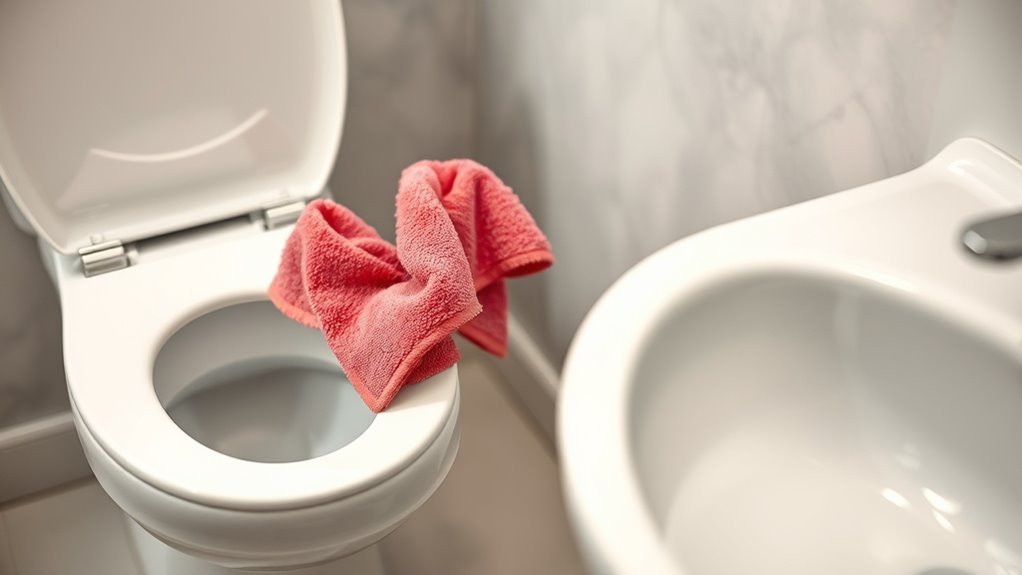
Many people make the critical error of using the same cloth to clean the toilet and other bathroom surfaces. This practice increases cross contamination risks, spreading germs and bacteria beyond the toilet bowl. To maintain hygiene and freedom from illness, you must adopt proper cleaning techniques by using separate cloths for different areas. Here’s how to avoid contamination:
- Designate one cloth exclusively for toilet cleaning
- Use a different cloth for sinks, counters, and mirrors
- Wash cloths thoroughly after each use or dispose of disposable wipes
- Store cloths separately to prevent accidental mixing
Additionally, using reusable gloves during cleaning further reduces the risk of spreading bacteria and protects your hands.
Forgetting to Ventilate the Bathroom
Ventilation is essential when cleaning your toilet to prevent the buildup of harmful fumes from cleaning products and to reduce moisture that promotes mold growth. You must guarantee proper bathroom airflow by opening windows or turning on exhaust fans before you start cleaning. This step not only protects your respiratory health but also supports mold prevention by keeping the environment dry. Neglecting ventilation traps chemicals in the air, increasing the risk of irritation and respiratory issues. Prioritize fresh air circulation during and after cleaning to maintain a safe, mold-free bathroom. Remember, controlling moisture and fumes isn’t optional—it’s a necessary part of effective toilet maintenance that preserves your freedom to breathe easy in your own home. Additionally, gathering necessary cleaning items nearby before starting can streamline the process and minimize the time spent in an unventilated space.
Not Allowing Cleaners Enough Time to Work
Although it might be tempting to rush through cleaning, not allowing your toilet cleaners enough time to work can seriously undermine their effectiveness. Cleaner dwell time is essential for breaking down stains, bacteria, and grime. Skipping this step compromises product effectiveness and leaves your toilet less sanitary.
To maximize cleaner dwell time:
- Apply the cleaner evenly, guaranteeing full coverage.
- Allow the product to sit for the recommended duration on the label.
- Avoid immediate scrubbing or flushing to let the solution penetrate.
- Use a timer if needed to guarantee sufficient waiting time.
Using Abrasive Tools That Scratch Porcelain
Taking the time to let your cleaner work properly is only part of the process; the tools you use can also make or break your results. Avoid abrasive scrubbers or steel wool, as these can cause permanent scratches on your toilet’s porcelain surface. Scratches not only mar the appearance but also compromise porcelain maintenance by creating crevices where bacteria can thrive. For effective scratches prevention, opt for soft-bristle brushes or non-abrasive sponges designed specifically for toilet cleaning. These tools clean thoroughly without damaging the finish, preserving your toilet’s smooth surface and extending its lifespan. Remember, maintaining porcelain integrity means choosing tools that respect its delicate nature. By doing so, you guarantee your toilet remains hygienic and visually appealing without sacrificing freedom from harsh cleaning consequences. Additionally, regular rinsing and drying of your cleaning tools helps maintain hygiene and prevents the spread of germs.
Frequently Asked Questions
How Often Should I Clean My Toilet for Optimal Hygiene?
For ideal hygiene, you should set a cleaning frequency of at least once a week. Regular cleaning prevents bacteria buildup and unpleasant odors, ensuring your toilet stays fresh and sanitary. If your household is larger or usage is high, consider cleaning more often. Prioritizing hygiene importance means you won’t have to worry about germs spreading or stains becoming stubborn. Stick to this routine, and you’ll maintain a clean, comfortable bathroom environment effortlessly.
Can Natural Cleaners Be as Effective as Chemical Ones?
You might wonder about the effectiveness comparison between natural cleaning and chemical cleaners. Natural cleaning solutions, like vinegar and baking soda, can be surprisingly effective for regular toilet maintenance. They’re safer and eco-friendly, giving you freedom from harsh chemicals. However, for tough stains or heavy buildup, chemical cleaners often work faster and more thoroughly. You’ll want to choose based on your cleaning needs and personal preferences for safety and environmental impact.
What Is the Best Way to Remove Hard Water Stains?
You’d think removing hard water stains would require a miracle, but it’s simpler than that. For effective stain removal, soak a pumice stone or scrub brush in white vinegar, then gently scrub the stains. Vinegar’s acidity breaks down mineral deposits, making them easier to wipe away. Rinse thoroughly afterward. This method’s powerful yet natural, giving you freedom from harsh chemicals while tackling stubborn hard water buildup efficiently and safely.
Should I Clean the Toilet Brush After Use?
Yes, you should clean your toilet brush after every use to maintain proper toilet brush hygiene. Rinse it thoroughly with hot water, then disinfect it using a bleach solution or a disinfectant spray. Allow it to dry completely before storing it to prevent bacteria buildup. Incorporating this step into your cleaning routine guarantees your brush stays effective and hygienic, keeping your bathroom fresher and safer for you and your family.
Is It Safe to Use Bleach in the Toilet Bowl?
You can use bleach in the toilet bowl, but you need to be cautious to guarantee toilet bowl safety. Bleach is effective at killing germs, but it can damage seals and pipes if overused or mixed with other cleaners. If you want a safer option, consider bleach alternatives like vinegar or baking soda—they’re gentler on your plumbing and still keep your toilet fresh. Always follow instructions and ventilate the area well.
